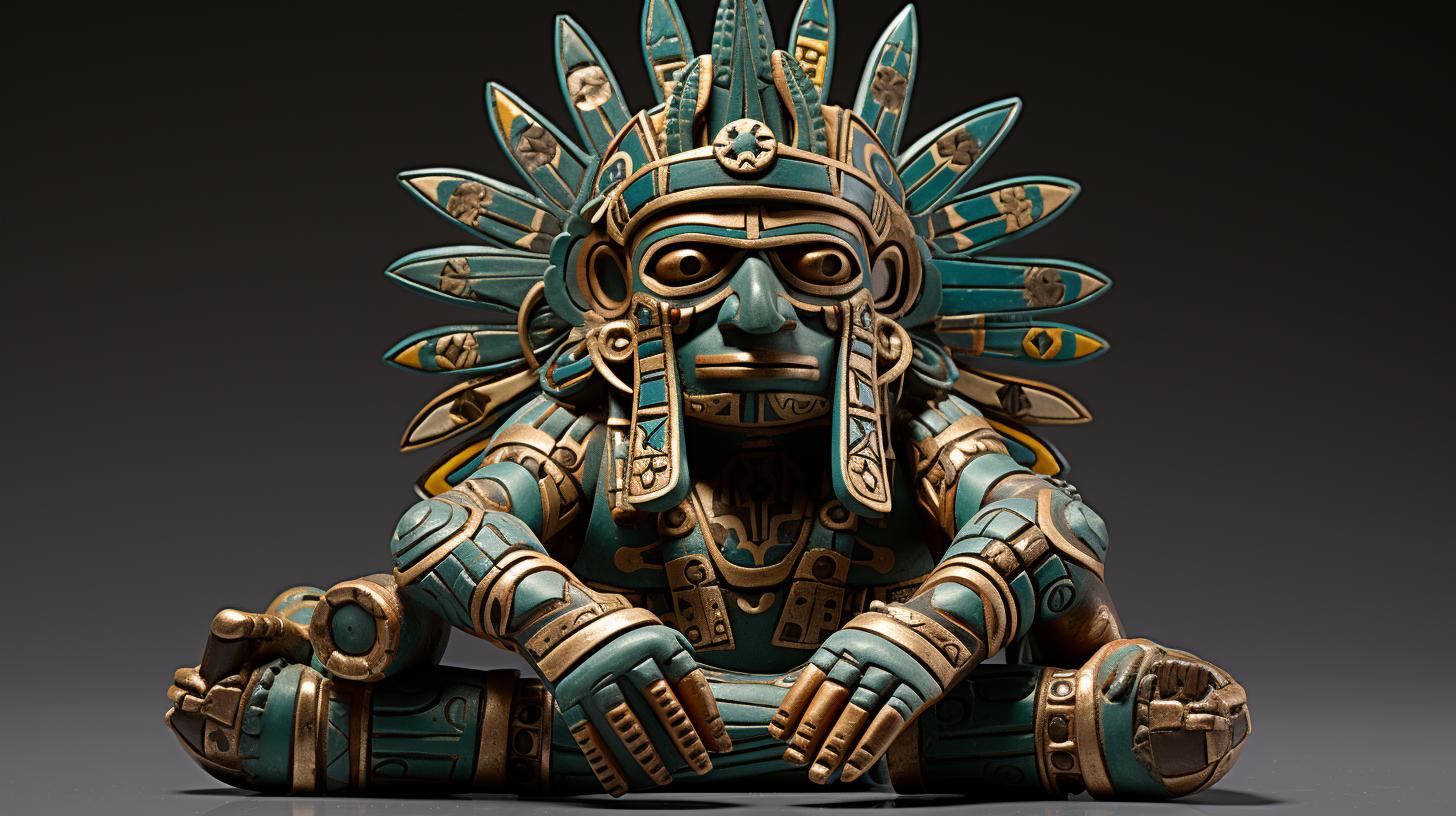Aztec Goddess Tonantzin: The Sacred Mother Earth of the Aztecs

In ancient Aztec culture, the goddess Tonantzin held a profound significance as the sacred mother earth. Her name, meaning “our sacred mother” in Nahuatl, symbolized the nurturing archetype of Mother Earth and the abundance she provided to her children.
Additionally, the link between Tonantzin and the Virgin of Guadalupe still resonates, honoring the belief that her appearance signaled the return of the Aztec mother goddess.
The Aztec goddess Tonantzin holds great significance in Aztec culture, representing the nurturing aspect of Mother Earth and the abundance she provides. Her origins and meaning delve into the depths of Aztec mythology, where she is revered as ‘our sacred mother’ in Nahuatl.
In the Aztec society, Tonantzin played a vital role in agricultural rituals and fertility ceremonies, receiving tributes and veneration from her devoted followers.
Origins and Meaning of Tonantzin
Tonantzin’s origins trace back to ancient Aztec mythology, where she emerged as the personification of the sacred mother earth. Her name, derived from the Nahuatl language, translates to ‘our sacred mother.’
Tonantzin embodies the loving archetype of Mother Earth, symbolizing fertility, love, and the giver of all sustenance. Her significance in Aztec culture reflects the deep-rooted connection between humanity and the natural world.
The Role of Tonantzin in Aztec Culture
In Aztec society, Tonantzin played a crucial role as the nurturing and protective deity. Through agricultural rituals and fertility ceremonies conducted by their ancestors, the Aztecs sought to honor and appease Tonantzin, believing that their devotion would ensure bountiful harvests and prosperous livelihoods.
The reverence for Tonantzin exemplified the Aztecs’ deep understanding of the interdependency between humans and nature, emphasizing the need for stewardship and sustainable practices in their agricultural endeavors.
Coatlicue Pronunciation and Significance in Aztec Mythology
In Aztec mythology, Coatlicue is a prominent deity with deep significance.
While the pronunciation may vary, it is commonly pronounced as “ko-at-lee-kweh.” Coatlicue is a complex and multifaceted figure, representing both creation and destruction.
Coatlicue’s name comes from the Nahuatl words “coatl,” meaning serpent, and “icue,” meaning skirt.
She is often depicted as a fearsome goddess with a serpentine skirt made of intertwined snakes. This imagery symbolizes her connection to the earth’s fertility and the cycles of life and death.
One of the most striking aspects of Coatlicue’s significance in Aztec mythology is her role as the mother of the gods. According to mythological accounts, she gave birth to the moon, stars, and Huitzilopochtli, the Aztec sun god and the patron deity of the Aztec empire.
Coatlicue’s association with both creation and destruction reflects the Aztec belief in the cyclical nature of the universe. She represents the continuous cycle of life, death, and rebirth, embodying the transformative power of the natural world.
Furthermore, Coatlicue is often regarded as a symbol of female power and strength. She defies traditional gender roles and challenges societal norms, embodying the fierce and protective aspects of motherhood while also embodying primordial chaos and creative potential.
The Connection between Tonantzin and the Virgin of Guadalupe
The intertwining relationship between Tonantzin, the revered Aztec goddess, and the Virgin of Guadalupe holds deep cultural and religious significance. The appearance of the Virgin of Guadalupe and her connection to the sacred site of Tonantzin’s shrine on the Hill of Tepeyac has had a profound impact on Nahuatl-speaking communities.
The Appearance of the Virgin of Guadalupe
In 1531, the Virgin of Guadalupe is said to have appeared to a Nahuatl-speaking indigenous man named Juan Diego on the Hill of Tepeyac. This holy apparition, often referred to as Our Lady of Guadalupe, represented a divine presence and became a significant figure in Mexican Catholicism.
Tonantzin and the Virgin of Guadalupe in Nahuatl-Speaking Communities
Even today, in Nahuatl-speaking communities, the Virgin of Guadalupe is referred to as “Tonantzin,” symbolizing the enduring connection with the ancient goddess. The annual celebration on December 12th commemorates the appearance of the Virgin of Guadalupe, reaffirming the belief in her representation as the return of the Aztec mother goddess.
The continued veneration of Tonantzin and the Virgin of Guadalupe highlights the fusion of indigenous beliefs with Catholicism in Mexico. This cultural synthesis has contributed to the rich tapestry of Mexican heritage and the profound influence of the sacred feminine in religious expressions.
Key Points:
- The Virgin of Guadalupe’s appearance on the Hill of Tepeyac held great significance for Nahuatl-speaking communities.
- Her role as Tonantzin, the nurturing mother figure, continues to be honored and celebrated.
- The connection between Tonantzin and the Virgin of Guadalupe showcases the blending of indigenous beliefs with Catholicism in Mexico.
- This cultural fusion deepens the reverence towards the sacred feminine in Mexican religious practices.
Tonantzin and the Preservation of Indigenous Cultures
Indigenous cultures hold Tonantzin as a symbol of great significance, representing their deep connection to the land and their ancestral heritage. Tonantzin is revered as a powerful embodiment of the nurturing and protective qualities of Mother Earth.
Her presence in Aztec culture has remained resilient, reflecting the enduring spirit of indigenous communities in Mexico.
The Symbolic Importance of Tonantzin
Tonantzin’s symbolic importance lies in her role as a representation of indigenous spirituality and their sacred relationship with the earth. She embodies the values of fertility, abundance, and the cycles of nature.
Tonantzin’s worship serves as a reminder of the profound wisdom and spirituality that indigenous cultures embrace, providing a source of inspiration and guidance for their communities.
Tonantzin as a Mexican National Symbol
Within the Mexican context, Tonantzin holds a significant place as a national symbol.
She represents the rich cultural heritage and deep-rooted indigenous traditions of Mexico. In combining elements of pre-Hispanic beliefs with Catholicism, the figure of Tonantzin represents the intricate blending of cultures that has shaped modern Mexico.
Her influence resonates not only within indigenous communities but also within the broader Mexican population, emphasizing the importance of honoring and preserving the diverse cultural tapestry of the nation.
Honoring Tonantzin: Rituals and Celebrations
One of the ways in which the revered Aztec goddess Tonantzin is honored is through various rituals and celebrations.
These sacred practices allow the community to come together and express their gratitude and devotion to Tonantzin, the embodiment of Mother Earth.
Rituals dedicated to Tonantzin often involve offerings, prayers, and ceremonies held in sacred spaces such as temples, shrines, or natural settings.
Participants engage in acts of purification and gratitude, seeking to establish a harmonious connection with the divine feminine energy represented by Tonantzin.
The celebrations dedicated to Tonantzin take place during significant dates and festivals throughout the year.
These events are marked by colorful processions, dances, and music that create a festive and joyful atmosphere. Participants adorn themselves with traditional garments and symbols, infusing the celebrations with cultural pride and spiritual reverence.
- Honoring the sacred mother earth through rituals and ceremonies
- Expressions of gratitude and devotion to Tonantzin
- Offerings, prayers, and acts of purification
- Celebrations during significant dates and festivals
- Colorful processions, dances, and music
- Traditional garments and symbols
These rituals and celebrations not only serve as a way to pay homage to the Aztec goddess Tonantzin but also act as a reminder of the interconnectedness between humans and the natural world.
They provide individuals and communities with an opportunity to express their love and respect for Mother Earth, and to reaffirm their commitment to living in harmony with nature.
Honoring Tonantzin through these rituals and celebrations is a powerful way to keep indigenous traditions alive and to preserve the rich cultural heritage of the Aztec civilization.
It allows individuals to connect with their roots, fostering a sense of identity and belonging within the community.
As the years go by, the importance of these rituals and celebrations remains strong, proving that the legacy of Tonantzin continues to inspire and guide people in their journey to honor and protect the sacred mother earth.
Unveiling the Mysteries: Deepening Our Understanding of Tonantzin
Exploring the enigmatic realm of Tonantzin allows us to delve deeper into the profound significance of this ancient Aztec goddess. By uncovering the mysteries that surround her worship and symbolism, we can gain a richer understanding of the cultural and religious beliefs associated with Tonantzin.
The legends and stories surrounding Tonantzin offer us glimpses into her role as the sacred mother earth in Aztec society. Through these narratives, we can grasp the reverence and adoration bestowed upon her by the Aztec people, who recognized her as a nurturing force, providing abundance and sustenance.
One of the intriguing aspects of Tonantzin’s worship is her connection to the Virgin of Guadalupe. While the exact nature of their relationship remains subject to speculation, the appearance of the Virgin on the hill of Tepeyac, where Tonantzin was once venerated, alludes to a merging of indigenous beliefs with Christian devotion.
The transformation of religious practices and beliefs surrounding Tonantzin reflects the complex fusion of Catholicism and pre-Hispanic traditions in Mexico. It is through this blending of cultural elements that we witness the profound influence of Tonantzin’s legacy on Mexican religious and cultural identity.
By deepening our understanding of Tonantzin, we can gain insight into the spiritual significance she holds for many communities today. Her role as a source of hope and unity resonates in a world overshadowed by materialism and disconnection from the natural world.
As we continue to explore the mysteries surrounding Tonantzin, we come to appreciate the importance of preserving indigenous perspectives and honoring the sacred traditions that have endured throughout history. Through these efforts, we can ensure that the legacy of Tonantzin continues to inspire and guide us, reminding us of our interconnectedness with the earth and the need to cherish and protect the natural world.
Exploring the Cultural Fusion: Catholicism and Pre-Hispanic Beliefs in Mexico
The cultural fusion between Catholicism and pre-Hispanic beliefs in Mexico is a fascinating aspect of the country’s history and religious practices. This fusion resulted from the colonization of Mexico by the Spanish, who brought Catholicism to the indigenous populations.
Underlying this fusion is the influence of the Catholic Church on the worship of Tonantzin, the Aztec goddess of the earth.
The Influence of the Catholic Church on Tonantzin Worship
With the arrival of the Spanish, Catholicism became the dominant religion in Mexico. In an effort to convert the indigenous population, the Catholic Church adapted some aspects of pre-Hispanic beliefs into its own practices.
As a result, the worship of Tonantzin was incorporated into the veneration of the Virgin Mary, specifically the image of the Virgin of Guadalupe.
The presence of the Virgin of Guadalupe, often referred to as Tonantzin in Nahuatl-speaking communities, bridged the gap between Catholicism and indigenous traditions.
The Catholic Church recognized the significance of Tonantzin and allowed her worship to continue, albeit within the framework of Catholicism.
The Transformation of Religious Practices and Beliefs
This fusion of Catholicism and pre-Hispanic beliefs led to the transformation of religious practices and beliefs in Mexico. Indigenous rituals and ceremonies intertwined with Catholic liturgical traditions, creating a unique syncretism.
The integration of pre-Hispanic symbols, rites, and beliefs into Catholic rituals allowed indigenous people to maintain their cultural identity while embracing a new faith.
Over time, the reverence for Tonantzin evolved, incorporating elements of Catholicism.
Rituals and celebrations associated with Tonantzin often blend indigenous practices with Catholic customs and are deeply rooted in Mexican culture.
This cultural fusion not only shaped religious practices but also influenced art, literature, and the national identity of Mexico.
The imagery of both Tonantzin and the Virgin of Guadalupe has become iconic, symbolizing the rich blend of indigenous and Spanish heritage that defines Mexican culture.
Exploring the cultural fusion of Catholicism and pre-Hispanic beliefs in Mexico allows us to understand the complex tapestry of religious syncretism that exists in the country today.
It highlights the resilience of indigenous traditions and the adaptability of Catholicism, forming a unique and diverse spiritual landscape in Mexico.
Tonantzin: A Source of Hope and Unity in the Modern World
Tonantzin, the Aztec goddess of the sacred mother earth, continues to hold deep significance in the modern world.
As humanity grapples with environmental challenges and a sense of disconnection from nature, Tonantzin serves as a beacon of hope and unity.
In a time when materialism and superficiality prevail, the reverence for Tonantzin offers a path towards reconnecting with the natural world.
Tonantzin’s symbolism goes beyond cultural and religious boundaries.
It transcends borders and unifies hearts by reminding us of the interdependence between humans and the earth. The goddess represents the urgent need for environmental stewardship and the importance of preserving indigenous cultures.
In a world filled with despair, Tonantzin brings a message of hope. She reminds us that by honoring and respecting the earth, we can find harmony and unity. Her legacy teaches us the value of living in balance with nature, and that through reverence for the land, we can heal ourselves and our planet.
Today, many individuals are embracing Tonantzin’s teachings and seeking ways to incorporate her wisdom into their lives. From engaging in sustainable practices to participating in rituals and celebrations honoring the goddess, people are rediscovering the power of connecting with the natural world.
As we navigate the complexities of the modern world, the importance of Tonantzin’s message cannot be overstated. She serves as a guiding light, reminding us of our intrinsic connection to the earth and our collective responsibility to protect and preserve it for future generations.
Tonantzin is not just a figure from the past, but a source of inspiration and empowerment in the present. By embracing her teachings and embodying her spirit, we can forge a path towards a more sustainable and harmonious world.
Preserving Tonantzin’s Legacy: Upholding Indigenous Perspectives
Preserving the legacy of Tonantzin goes beyond mere recognition of her significance in Aztec culture. It requires a deep commitment to upholding indigenous perspectives and honoring the ancestral knowledge that she represents.
One crucial aspect of preserving Tonantzin’s legacy is giving indigenous communities a platform to share their stories, rituals, and beliefs. By amplifying their voices and acknowledging their wisdom, we can foster understanding and appreciation for their cultural heritage.
Education also plays a vital role in upholding indigenous perspectives. It is essential to teach future generations about the rich history and spirituality associated with Tonantzin, allowing them to recognize the interconnectedness of all living beings and the sacredness of the natural world.
- Supporting and participating in indigenous-led events and initiatives is another way to honor Tonantzin’s legacy. By attending ceremonies, celebrations, and gatherings, we actively engage with indigenous communities and their traditions, fostering a deeper sense of respect and admiration.
- Efforts should be made to collaborate with indigenous artists, scholars, and activists.By providing platforms for their work, we can contribute to the preservation and promotion of indigenous perspectives, allowing their voices to reach a wider audience.
- Respecting indigenous lands, sacred sites, and natural resources is essential to honoring Tonantzin’s legacy.By advocating for environmental protection and sustainable practices, we demonstrate our commitment to preserving the interconnectedness between humans and the natural world.
- Engaging in ongoing dialogue and consultation with indigenous communities is crucial for understanding their needs, concerns, and aspirations.By actively listening and learning from their experiences, we can build meaningful partnerships based on mutual respect and shared goals.
Preserving Tonantzin’s legacy requires ongoing dedication and a willingness to actively support indigenous communities.
By upholding their perspectives, recognizing their contributions, and amplifying their voices, we ensure that the sacred teachings and wisdom embodied by Tonantzin continue to enrich and inspire generations to come.




















